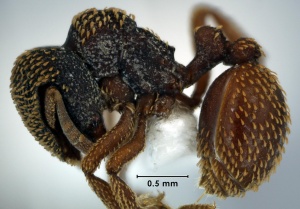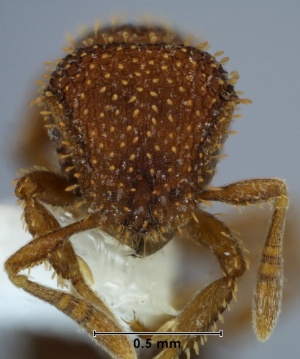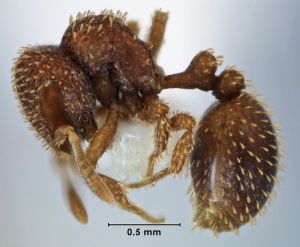Key to Australian Calyptomyrmex Species
The following key to Australian Calyptomyrmex species has been modified from Shattuck (2011[1]).
1
- Hairs on head and body spatulate (noticeably narrower near the body and expanded distally and with a rounded tip) => 2
- Hairs on head and body thin (essentially the same width along entire length, or only slightly and gradually expanded distally, and with blunt tips) => 6
2
- Gaster with low longitudinal striations running between the spatulate hairs (Australia) => Calyptomyrmex fragarus
- Gaster smooth to shallowly punctate => 3
3
- Propodeum armed with short angular teeth => 4
- Propodeum unarmed => 5
4
- In dorsal view node of petiole much broader than long and rectangular in shape; body smaller (head width < 0.82mm) => Calyptomyrmex fritillus
- In dorsal view node of petiole only slightly broader than long and oval in shape; body larger (head width > 1.00mm) => Calyptomyrmex sparsus
5
- Hairs on head narrowly spatulate and rising well above the underlying body surface; in dorsal view node of petiole rectangular, in lateral view relatively thin; body smaller (head width < 0.82mm) (Australia) => Calyptomyrmex taylori
- Hairs on head broadly spatulate and appressed closely to the underlying body surface; in dorsal view node of petiole rounded, in lateral view relatively thick; body larger (head width > 0.90mm) => Calyptomyrmex beccarii
6
- Gaster heavily sculptured with striations or a network of low rugae => Calyptomyrmex lineolus
- Gaster weakly (and sometimes indistinctly) punctate => 7
7
- Mesonotum rugo-reticulate but with rugae running longitudinally; propodeal spines shorter; petiolar node in dorsal view broader and thinner => Calyptomyrmex grammus
- Mesonotum rugo-reticulate but lacking longitudinal rugae; propodeal spines longer; petiolar node in dorsal view narrower and thicker => Calyptomyrmex ocullatus
References
- ↑ Shattuck, S.O. (2011) Revision of the ant genus Calyptomyrmex (Hymenoptera: Formicidae) in South-east Asia and Oceania. Zootaxa 2743:1-26.















